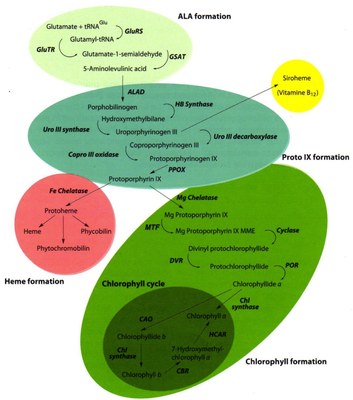Tetrapyrrole Metabolism
Metallo-tetrapyrrolic compounds are widespread in nature and have indispensable functions as prosthetic groups in many metabolic and energy transduction pathways. Plant tetrapyrrole biosynthesis is one of the most important processes in chloroplasts. It serves for essential co-factors of enzymes catalyzing redox reactions (heme), co-factors for the enzymes of the nitrogen fixation pathway (siroheme), leads to the production of the ubiquitous chlorophyll molecules and is involved in plastid-derived retrograde signaling.
The pathway for chlorophyll and heme biosynthesis is divided in at least five parts (see figure below):
- ALA biosynthesis
- Protoporphyrin IX synthesis
- Chlorophyll synthesis in the Mg branch including the chlorophyll cycle
- Heme synthesis in the Fe branch
- Siroheme synthesis

A tight control of tetrapyrrole biosynthesis is required because of the photodynamic risk of accumulating tetrapyrrole intermediates and need of continuously adjusted synthesis of endproducts in response to varying demands during photoperiodic growth. As in many metabolic pathways the main control steps are positioned at the beginning, at the branch points and at the final steps of the pathway.
OBJECTIVES
The pathway is regulated by environmental stimuli and stress factors, plastid-derived signalling as well as transcriptional control and posttranslational modification of enzymes. The Plant Physiology Group explores complex posttranslational control and the spatio-temporal organization of the tetrapyrrole biosynthetic pathway leading to chlorophyll and heme.
PROJECTS